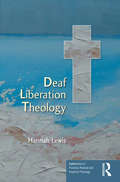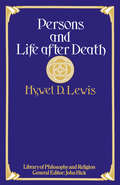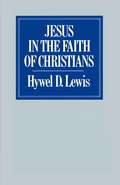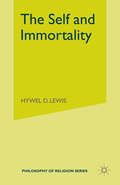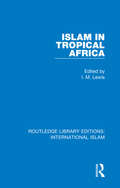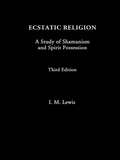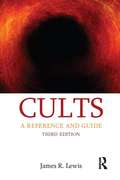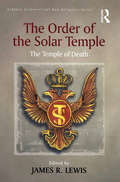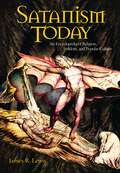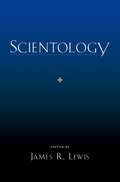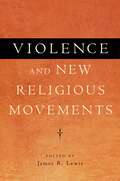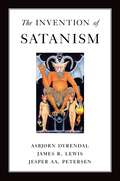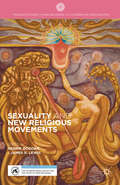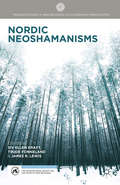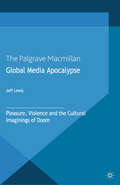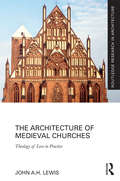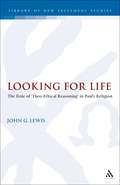- Table View
- List View
Deaf Liberation Theology (Explorations in Practical, Pastoral and Empirical Theology)
by Hannah LewisFollowing years of theology of deafness based on the premise that Deaf people are simply people who cannot hear, this book breaks new ground. Presenting a new approach to Deaf people, theology and the Church, this book enables Deaf people who see themselves as members of a minority group to formulate their own theology rooted in their own history and culture. Deconstructing the theology and practice of the Church, Hannah Lewis shows how the Church unconsciously oppresses Deaf people through its view of them as people who cannot hear. Lewis reclaims Deaf perspectives on Church history, examines how an essentially visual Deaf culture can relate to the written text of the Bible and asks 'Can Jesus sign?' This book pulls together all these strands to consider how worship can be truly liberating, truly a place for Deaf people to celebrate who they are before God.
Islam in Tropical Africa (Routledge Library Editions: International Islam #4)
by I. M. LewisFirst published in 1980, this second edition of Islam in Tropical Africa presents specialist studies of the history and sociology of Muslim communities in Africa south of the Sahara. The studies cover an extensive and range of time and place, and include consideration of particular aspects of Muslim belief and practice in regions such as Senegal and Somalia. The second edition includes an updated introduction which draws attention to the ways in which differently organized traditional cultures and social systems had reacted and adapted to Muslim influence in the field of politics, law and ritual in the second half of the twentieth century. This book will be of interest to those studying Islam, African studies and ethnography.
Islam in Tropical Africa (Routledge Library Editions: International Islam #4)
by I. M. LewisFirst published in 1980, this second edition of Islam in Tropical Africa presents specialist studies of the history and sociology of Muslim communities in Africa south of the Sahara. The studies cover an extensive and range of time and place, and include consideration of particular aspects of Muslim belief and practice in regions such as Senegal and Somalia. The second edition includes an updated introduction which draws attention to the ways in which differently organized traditional cultures and social systems had reacted and adapted to Muslim influence in the field of politics, law and ritual in the second half of the twentieth century. This book will be of interest to those studying Islam, African studies and ethnography.
Ecstatic Religion: A Study of Shamanism and Spirit Possession
by I.M. LewisFirst Published in 2004. Routledge is an imprint of Taylor & Francis, an informa company.
Ecstatic Religion: A Study of Shamanism and Spirit Possession
by I.M. LewisFirst Published in 2004. Routledge is an imprint of Taylor & Francis, an informa company.
Cults: A Reference and Guide (Approaches to New Religions)
by James R. LewisCults examines the history and current status of cults across the United States, Europe, and East Asia. Focusing on the principal controversial religions and movements that have attracted major media attention, the book also includes profiles of hundreds of minority religions, from Jesus People and Rastafarians to voodoo practitioners and the human-cloning Raelians. All the issues central to the practice and the fear of cults are examined - apocalypticism, deprogramming, social isolation, cults and the media, the use and threat of violence, child custody, libel, tax evasion, solicitation, and the techniques of persuasion and conviction - as are the many charismatic cult leaders. Cults presents a comprehensive and authoritative reference, offering a balanced view of the controversy surrounding these new religious movements, assessing the movements themselves as well as the legal and governmental responses to them, including attempts to quantify membership.
Cults: A Reference and Guide (Approaches to New Religions)
by James R. LewisCults examines the history and current status of cults across the United States, Europe, and East Asia. Focusing on the principal controversial religions and movements that have attracted major media attention, the book also includes profiles of hundreds of minority religions, from Jesus People and Rastafarians to voodoo practitioners and the human-cloning Raelians. All the issues central to the practice and the fear of cults are examined - apocalypticism, deprogramming, social isolation, cults and the media, the use and threat of violence, child custody, libel, tax evasion, solicitation, and the techniques of persuasion and conviction - as are the many charismatic cult leaders. Cults presents a comprehensive and authoritative reference, offering a balanced view of the controversy surrounding these new religious movements, assessing the movements themselves as well as the legal and governmental responses to them, including attempts to quantify membership.
The Order of the Solar Temple: The Temple of Death (Routledge New Religions)
by James R. LewisIn October 1994, fifty-three members of the Order of the Solar Temple in Switzerland and Québec were murdered or committed suicide. This incident and two later group suicides in subsequent years played a pivotal role in inflaming the cult controversy in Europe, influencing the public to support harsher actions against non-traditional religions. Despite the importance of the Order of the Solar Temple, there are relatively few studies published in English. This book brings together the best scholarship on the Solar Temple including newly commissioned pieces from leading scholars, a selection of Solar Temple documents, and important previously published articles newly edited for inclusion within this book. This is the first book-length study of the Order of the Solar Temple to be published in English.
The Order of the Solar Temple: The Temple of Death (Routledge New Religions)
by James R. LewisIn October 1994, fifty-three members of the Order of the Solar Temple in Switzerland and Québec were murdered or committed suicide. This incident and two later group suicides in subsequent years played a pivotal role in inflaming the cult controversy in Europe, influencing the public to support harsher actions against non-traditional religions. Despite the importance of the Order of the Solar Temple, there are relatively few studies published in English. This book brings together the best scholarship on the Solar Temple including newly commissioned pieces from leading scholars, a selection of Solar Temple documents, and important previously published articles newly edited for inclusion within this book. This is the first book-length study of the Order of the Solar Temple to be published in English.
Satanism Today: An Encyclopedia of Religion, Folklore, and Popular Culture
by James R. LewisThis authoritative reference work presents a full image of the Prince of Darkness as he appears throughout traditional theology, mythology, art and literature, and popular culture.This nonsensationalist encyclopedia examines contemporary images of the devil and sorts out the many different forms these images take. Although much of the myths relating to Satan derive directly or indirectly from the Christian tradition, the key sources of diabolical images today are horror movies, heavy metal music, and conservative Christian literature.This encyclopedia gives a brief overview depicting the history and transformation of the meaning of the Prince of Darkness, and 300 entries cover subjects like the angel of death, backward masking (messages revealed when songs are played backward), neopagan witchcraft, UFOs, and The Satanic Bible. Extensive appendixes include the l992 FBI study of satanic ritual abuse, the most influential document ever written on the subject, as well as sample satanic scriptures and a satanic wedding ceremony. Satanism Today also includes a chronology, bibliographies, and references.
Scientology (Brill Handbooks On Contemporary Religion Ser. #14)
by James R. LewisScientology is arguably the most persistently controversial of all contemporary New Religious Movements. James R. Lewis has assembled an unusually comprehensive anthology, incorporating a wide range of different approaches. In this book, a group of well-known scholars of New Religious Movements offers an extensive and evenhanded overview and analysis of all of these aspects of Scientology, including the controversies to which it continues to give rise.
Scientology
by James R. LewisScientology is arguably the most persistently controversial of all contemporary New Religious Movements. James R. Lewis has assembled an unusually comprehensive anthology, incorporating a wide range of different approaches. In this book, a group of well-known scholars of New Religious Movements offers an extensive and evenhanded overview and analysis of all of these aspects of Scientology, including the controversies to which it continues to give rise.
Violence and New Religious Movements
by James R. LewisThe relationship between new religious movements (NRMs) and violence has long been a topic of intense public interest--an interest heavily fueled by multiple incidents of mass violence involving certain groups. Some of these incidents have made international headlines. When New Religious Movements make the news, it's usually because of some violent episode. Some of the most famous NRMs are known much more for the violent way they came to an end than for anything else. Violence and New Religious Movements offers a comprehensive examination of violence by-and against-new religious movements. The book begins with theoretical essays on the relationship between violence and NRMs and then moves on to examine particular groups. There are essays on the "Big Five"--the most well-known cases of violent incidents involving NRMs: Jonestown, Waco, Solar Temple, the Aum Shunrikyo subway attack, and the Heaven's Gate suicides. But the book also provides a richer survey by examining a host of lesser-known groups. This volume is the culmination of decades of research by scholars of New Religious Movements.
Violence and New Religious Movements
by James R. LewisThe relationship between new religious movements (NRMs) and violence has long been a topic of intense public interest--an interest heavily fueled by multiple incidents of mass violence involving certain groups. Some of these incidents have made international headlines. When New Religious Movements make the news, it's usually because of some violent episode. Some of the most famous NRMs are known much more for the violent way they came to an end than for anything else. Violence and New Religious Movements offers a comprehensive examination of violence by-and against-new religious movements. The book begins with theoretical essays on the relationship between violence and NRMs and then moves on to examine particular groups. There are essays on the "Big Five"--the most well-known cases of violent incidents involving NRMs: Jonestown, Waco, Solar Temple, the Aum Shunrikyo subway attack, and the Heaven's Gate suicides. But the book also provides a richer survey by examining a host of lesser-known groups. This volume is the culmination of decades of research by scholars of New Religious Movements.
The Invention of Satanism
by James R. Lewis Asbjorn Dyrendal Jesper Aa. PetersenSatanism is a complex phenomenon that has often been the source of controversy across social and rhetorical contexts. Some consider it the root of all evil. Others see it as a childish form of rebellion or as a misapplication of serious esoteric beliefs and practices. Still others consider it a specific religion or philosophy that serves as a form of personal and collective identity. In The Invention of Satanism, three experts explore Satanism as a contemporary movement that is in continuous dialogue with popular culture, and which provides a breeding ground for other new religious movements. By shifting the focus from mythology to meaning-making, this book examines the invention of Satanism among self-declared religious Satanists. Like all ideologists and believers, Satanists incorporate, borrow, and modify elements from other traditions; the authors investigate how traditional folklore and prior strands of occultism were synthesized by Anton LaVey in his founding of the Church of Satan and creation of the Satanic Bible. Later chapters discuss contemporary Satanist subcultures, demonstrating how Satanism continues to reinvent itself despite its brief history as an organized phenomenon. There are now numerous forms of Satanism with distinctive interpretations of what being a Satanist entails, with some of these new versions deviating more from the historical "mainstream" than others. In this fascinating account of a seemingly arcane and often-feared movement, Dyrendal, Lewis, and Petersen demonstrate that the invention of Satanism is an ongoing, ever-evolving process.
Sexuality and New Religious Movements (Palgrave Studies in New Religions and Alternative Spiritualities)
by James R. Lewis Edited by Henrik BogdanIssues relating to sexuality, eroticism and gender are often connected to religious beliefs and practices, but also to prejudices against and fear of religious groups that adopt alternative approaches to sexuality. This is especially apparent in connection with new religious movements, which many times find themselves accused by the media and anti-cultists of promoting illicit and controversial views on sexuality. This anthology aims to critically investigate the role of sexuality in a number of new religious movements, including Mormon fundamentalist communities, the Branch Davidians, the Osho movement, the Raël movement, contemporary Wicca and Satanism, in addition to the teachings of Adidam and Gurdjieff on sexuality.
Nordic Neoshamanisms (Palgrave Studies in New Religions and Alternative Spiritualities)
by James R. Lewis Siv Ellen Kraft Trude FonnelandThis book proposes that the drive for religiosity and experiences of the sacred are far from lost in contemporary western societies. The contributors' objective is to explore the myriad of ways late modern shamanism is becoming more vital and personally significant to people, communities, and economies in Nordic countries.
Global Media Apocalypse: Pleasure, Violence and the Cultural Imaginings of Doom
by Jeff LewisThe modern world seems trapped between fantasies of infinite pleasure and the prospects of total global catastrophe. Global Media Apocalypse explores these contrary imaginings through an evolving cultural ecology of violence. Articulated through the global media, these apocalyptic fantasies express a profoundly human condition of crisis.
The Architecture of Medieval Churches: Theology of Love in Practice (Routledge Research in Architecture)
by John A.H. LewisThe Architecture of Medieval Churches investigates the impact of affective theology on architecture and artefacts, focusing on the Middle Ages as a period of high achievement of this synthesis. It explores aspects of medieval church and cathedral architecture in relation to the contemporary metaphysics and theology, which articulated an integrated theocentric culture, architecture, and art. Three modes of attention: comprehension, instruction, and contemplation, informed the builders’ intuition and intention. The book’s central premise reasons that love for God was the critical force in the creation of vernacular church architecture, using a selection of medieval writings to provide a unique critique of the genius of architecture and art during this period. An interdisciplinary study between architecture, theology, and philosophy, it will appeal to academics and researchers in these fields.
The Architecture of Medieval Churches: Theology of Love in Practice (Routledge Research in Architecture)
by John A.H. LewisThe Architecture of Medieval Churches investigates the impact of affective theology on architecture and artefacts, focusing on the Middle Ages as a period of high achievement of this synthesis. It explores aspects of medieval church and cathedral architecture in relation to the contemporary metaphysics and theology, which articulated an integrated theocentric culture, architecture, and art. Three modes of attention: comprehension, instruction, and contemplation, informed the builders’ intuition and intention. The book’s central premise reasons that love for God was the critical force in the creation of vernacular church architecture, using a selection of medieval writings to provide a unique critique of the genius of architecture and art during this period. An interdisciplinary study between architecture, theology, and philosophy, it will appeal to academics and researchers in these fields.
Looking for Life: Looking For Life: The Role Of 'theo-ethical Reasoning' In Paul's Religion (The Library of New Testament Studies #291)
by John G. LewisThrough exegetical studies of 1 Corinthians and Galatians, John Lewis shows how Paul synthesises theology and ethics - which interpreters frequently separate - as integrated aspects of Christian thinking and living. This fusion becomes evident in Paul's complex process of theological, moral reasoning that lies beneath the surface of his letters for which we have coined the phrase 'theo-ethical reasoning'. The book also examines how Paul encourages his churches to apply this theo-ethical reasoning in the community practice of spiritual discernment - a dialogical, comparative process of reasoned reflection on behaviour and experience. Through this practice of looking for life, community members are led by the Spirit as they reason together, attempting to associate the manifestations of new life with conduct that faithfully portrays Christ's self-giving pattern. This correlation of conduct with experience grounds Paul's own proclamation of Jesus Christ in word and deed. It also becomes the foundation for believers' faith and hope as they come to know Christ and experience the power of God. Thus, the book concludes that the practice of spiritual discernment by means of theo-ethical reasoning lies at the centre of Paul's religion.
Lonesome: The Spiritual Meanings of American Solitude (Library of Modern Religion)
by Kevin LewisThere is another loneliness', wrote the American poet Emily Dickinson: 'Not want of friend occasions it, but nature sometimes, sometimes thought'. For Kevin Lewis, that 'other loneliness' is uniquely expressive of a rich and resonant state of being that is distinctive to the American psyche as well as central to the mythology of America itself. He calls this state of being 'lonesomeness'. It evokes the luminous landscapes of the West and the cathedral-like space of the Great Plains. It lies at the root of personal identity and is inseparable from notions of personal discovery and of communion with the varied topography of the United States, whether it be rural hinterland or industrial urban rustbelt. In this continuously stimulating reflection, Kevin Lewis explores - in religion, poetry, fiction, country songwriting and art - the multiple meanings of that peculiarly American notion of solitariness. Discussing quintessential American writers like Henry David Thoreau, Walt Whitman, Jack Kerouac and Ernest Hemingway - creative artists who have all embraced positive conceptions of solitude and wilderness - Lewis finds the apex of American lonesomeness in the melancholic and reflective paintings of Edward Hopper. Lewis argues that in expressive works like Nighthawks, Hotel Room and Morning Sun one sees Hopper's solitude redeemed by 'something more': by the notion that in isolation the individual may yet be touched by transcendence. Kevin Lewis argues that those echoes of 'something else' reveal a great deal about the American character that we would do well to heed, as well as deep rooted cultural attitudes towards religion, individualism and self-belief
